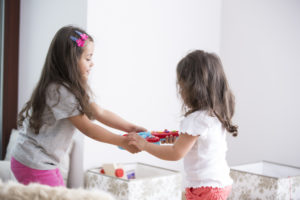
“Stop!” I heard six-year-old Alan tell a couple of three-year-old girls. “I think you’ve got a problem.”
Lila and Susan, the three-year-olds, were tugging and grunting to see who would get possession of a puzzle. Alan continued, “I think you both want to do this puzzle by yourself. Do you want to work this out? “
Lila and Susan stopped, looked at Alan, and nodded in agreement. “You can either take turns or choose something else. What do you think is best?” Alan politely asked them.
I watched this classroom scene unfold as Susan decided to choose another puzzle and Lila promised to let Susan know when she was finished using the puzzle. No tears. No hitting. I witnessed peaceful problem solving with no adult intervention.
“No way!” you are probably thinking. “That’s just not real.” As a friend of mine said, “Alan sure doesn’t sound like any six-year-old I know.” It can be a typical scenario if we will show young children a simple five-step problem solving technique. By the time they are six, they will sound older than their years.
A basic ground rule in conflict resolution with children is that they must use their words to solve their problems. There is to be no hitting, biting, kicking, or name-calling; in short, no action intended to harm others may be used. The adult’s initial role is to step the children through the process, acting as facilitator. Like Alan, at some point, the child will step into the facilitator’s role. Let’s look at this five-step problem solving method.
Step 1: Recognizing a problem.
In my example, six-year-old Alan saw two children struggling with a puzzle. So, he said “Stop. I think you’ve got a problem.” This statement helps those in conflict disengage and shift their focus. Sometimes just stopping will help us see our actions and change our behavior without any other intervention. If the behavior does continue, we need to make sure the children in conflict stop before we move to the next step in problem solving.
Step 2: Identifying the problem.
Alan at this point said, “I think you both want to use the puzzle at the same time.” Susan or Lila might have said, “No, that’s not the problem. She’s putting the puzzle in the wrong place.” As facilitators, we have to listen to make sure the problem is clearly stated and that everyone agrees to work on the problem before we move on to the next step.
Step 3: Brainstorming for solutions.
As adults, we’ll see solutions to the problem before the children. State these and ask if they can think of any more suggestions. It’s easy as an adult to want to quickly resolve a situation and force our solution. We’re trying to teach the process, so give the children time to think of other solutions and evaluate all suggestions before moving on to the next step.
Step 4: Choosing the best solution
After the group agrees that they have looked at all the possible solutions, it will be time to pick the best one. Restate all the solutions and have them choose the best one. State the selected solution clearly, as in our example: Susan will choose another puzzle, and Lila promises to let Susan know when she is finished.
Step 5: Checking back to make sure it’s working.
This is the step that is easy to forget. It is important to check back with each person to make sure the solution is working. If not, call back the children and restart the problem-solving process again.
The first few times as a facilitator with children, this process may seem very long and formal. I used to have a hand-made poster in my classroom to remind everyone of each step. Amazingly, using these five steps consistently, children realize the process works and will begin to problem solve on their own. Even after children are independently problem solving, we may have to step in every once in a while to get the process back on track.
Remember, we all forget once in awhile! Be kind if you or the children do the steps less than perfectly. Children are resilient.
One of my favorite parenting sayings is this: It’s hard to remember the objective is to drain the swamp, when you’re up to your eyeballs in alligators. Parenting is tough. We’re all just trying to do the best we can.
Begin using this problem-solving method with your three to six-year-olds to create a foundation for a lifetime of effective problem solving. What you might get in return is a teenager who, instead of slamming a door, comes to you saying, “Mom, Dad, I have a problem. Here are some possible solutions. Can you help me think of anymore?”’ Stranger things have happened.
Consider using this problem-solving tool today, whatever your children’s ages. Count to ten when the squabbling begins and use this five-step method to help your children learn to solve disputes.

